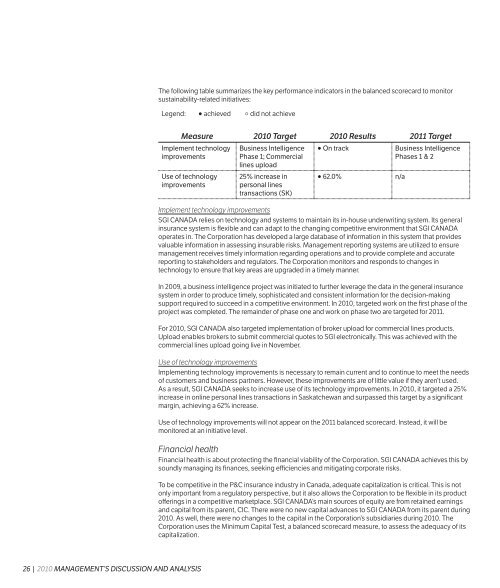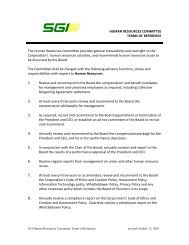Full report - SGI Canada
Full report - SGI Canada
Full report - SGI Canada
You also want an ePaper? Increase the reach of your titles
YUMPU automatically turns print PDFs into web optimized ePapers that Google loves.
Employee future benefits<br />
The Corporation’s benefit expense for its defined benefit pension plan and defined benefit service<br />
recognition plans is calculated by the Corporation’s external benefits actuary utilizing management’s<br />
best estimate of critical assumptions. These critical assumptions consist of: expected plan investment<br />
performance, salary escalation, age at retirement, mortality of members and future pension indexing.<br />
Management reviews and adjusts these assumptions as required on an annual basis. The financial impact<br />
of changing these assumptions, along with actual experience being different from the assumptions, is<br />
reflected in income on the Consolidated Statement of Operations.<br />
The end of period discount rate is determined at each year-end using market rates of high-quality debt<br />
instruments with cash flows that match the timing and amount of expected benefit payments.<br />
Further details of the Corporation’s defined benefit plans are contained in note 16 to the consolidated<br />
financial statements.<br />
Risk Management<br />
Risk Management is a process for recognizing and addressing risks that could affect the achievement<br />
of corporate objectives. On an annual basis, management reviews the key risks faced by <strong>SGI</strong> CANADA<br />
by identifying specific risk events and their potential impact on the Corporation’s operations, finances<br />
and reputation. Each risk event is rated based on the likelihood of the event occurring and severity of the<br />
consequences if it did occur, both before and after the application of potential mitigations.<br />
The above process results in a risk profile for the Corporation, which is reviewed by the Risk Committee of<br />
the Board of Directors. <strong>SGI</strong>’s Audit Services department also uses the risk profile in developing its annual<br />
work plan, which provides an assurance component to <strong>SGI</strong>’s risk management process.<br />
The following risks represent the most serious threat to <strong>SGI</strong> CANADA. Failure to manage any of these risks<br />
could lead to significant operational, financial or reputational damage. The nature of these risks, along with<br />
efforts to mitigate them, is summarized below.<br />
Significant privacy breach<br />
Risk: Personal information held by <strong>SGI</strong> CANADA for a large number of customers is lost, accessed or<br />
disclosed to an unauthorized party, resulting in adverse legal, regulatory and financial<br />
consequences, as well as a loss in confidence by customers and the shareholder.<br />
Mitigation: Specific guidelines on how to handle personal information have been developed and, to<br />
improve employees’ awareness of corporate privacy obligations, online privacy training and<br />
the annual sign-off of the Code of Ethics and Conduct, and the Confidentiality and Non-<br />
Disclosure Agreement is required for all staff. <strong>SGI</strong> CANADA has also implemented payment card<br />
standards that do not allow the retention of electronic customer credit card information<br />
and minimizes the exposure for paper-based sources. In 2009, the Corporation began<br />
conducting privacy audits in areas that handle customer information, and continues to work<br />
on the development of administrative, physical and technical safeguards to reduce the likelihood<br />
and magnitude of a privacy breach.<br />
Competition<br />
Risk: Changes to the competitive landscape lead to reduced margins and/or loss of market share. These<br />
changes include use of data and technology to target customers and the acquisition of business<br />
through the Internet.<br />
Mitigation: <strong>SGI</strong> CANADA’s response to increased competition has been through providing superior<br />
service to its broker network including broker training on new products and technology. Outside<br />
Saskatchewan, <strong>SGI</strong> CANADA has improved brokers’ contingent profit commission and appointed<br />
brokers that utilize the Internet to attract customers. To become more market-focused,<br />
<strong>SGI</strong> CANADA is reorganizing its underwriting function using a product management approach, and<br />
is developing a marketing strategy to increase the focus on customer requirements.<br />
Catastrophic claims loss<br />
Risk: An event loss in excess of reinsurance limits, an aggregation of large losses within the corporate net<br />
retention or the failure of a reinsurer could result in major financial losses for <strong>SGI</strong> CANADA.<br />
Mitigation: <strong>SGI</strong> CANADA’s reinsurance limits were determined based on independent catastrophe<br />
modeling, using a 1-in-250-year event assumption to calculate probable maximum loss. To mitigate<br />
the risk of reinsurer failure, <strong>SGI</strong> CANADA and its reinsurance brokers monitor the reinsurer rating<br />
provided by AM Best, and Standard and Poors.<br />
Transfer and acquisition of expertise<br />
Risk: <strong>SGI</strong> CANADA is unable to build and maintain the knowledge, skill and experience within the<br />
organization’s workforce needed to thrive now and in the future, resulting in lower productivity,<br />
higher operating costs and higher health and safety concerns from overworked employees.<br />
Challenges include retirements, recruitment of qualified personnel in a tight labour market and the<br />
need to support an analytical culture.<br />
Mitigation: <strong>SGI</strong> CANADA has implemented a number of programs in this area, including competencybased<br />
recruitment, mentoring programs and the monitoring of workplace engagement and<br />
strategic clarity through employee surveys. A corporate learning strategy was created in 2008 to<br />
grow people talent in support of a high-performing organization, and <strong>SGI</strong> CANADA has devoted<br />
additional resources to training and development. <strong>SGI</strong>’s succession planning process focuses on<br />
ensuring current senior management positions have backups and identifying high performing staff<br />
who have potential for more senior roles.<br />
Systems security<br />
Risk: The security of <strong>SGI</strong> CANADA’s systems is compromised by a virus attack, system breach, or<br />
unauthorized access to confidential or sensitive information by internal or external parties, resulting<br />
in significant financial and reputational damage.<br />
Mitigation: <strong>SGI</strong> CANADA created an Information Technology Security Policy in 2009, which includes<br />
corporate standards for user access (including remote and external vendor access), passwords,<br />
physical security and wireless networks. Antivirus, email filtering, firewalls and intrusion monitoring<br />
are used, and the Corporation has a formal disposal process for all systems hardware. <strong>SGI</strong> has also<br />
developed incident response procedures to decrease the severity of a breach, should one occur.<br />
Customer focus<br />
Risk: <strong>SGI</strong> CANADA is unable to identify or anticipate the needs of its policyholders and brokers, meet<br />
those needs due to lack of internal collaboration or utilize the Internet to market products due to its<br />
commitment to the broker distribution channel, leading to a loss of customers and market share.<br />
Mitigation: <strong>SGI</strong> CANADA identifies the needs of its customers through claims customer surveys, broker<br />
surveys and councils, as well as feedback from regional representatives, and works with the broker<br />
community to address gaps in products or service. Annual product reviews are conducted internally to<br />
identify pricing and coverage changes. As noted above, <strong>SGI</strong> CANADA is also developing a<br />
marketing strategy to increase the focus on customer requirements, which will include promoting<br />
the benefits of working with a broker and encouraging brokers to initiate selling over the Internet.<br />
52 | 2010 MANAGEMENT’S DISCUSSION AND ANALYSIS MANAGEMENT’S DISCUSSION AND ANALYSIS 2010 | 53















